

Scientia Silvae Sinicae ›› 2020, Vol. 56 ›› Issue (2): 174-183.doi: 10.11707/j.1001-7488.20200220
Previous Articles Next Articles
Li Gu1,Ping He1,2,Hongping Deng1,2,*,Dongping Ni1,Qian Wang1,Lideng Cheng1,Luoju Ba1
Received:2019-03-06
Online:2020-02-25
Published:2020-03-17
Contact:
Hongping Deng
CLC Number:
Li Gu,Ping He,Hongping Deng,Dongping Ni,Qian Wang,Lideng Cheng,Luoju Ba. A Morphology Study on Floral Organ Development Process of Eurya obtusifolia[J]. Scientia Silvae Sinicae, 2020, 56(2): 174-183.
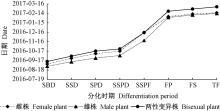
Fig.1
Blossoming phenophase among different sexes of E. obtusifolia SBD: Stage of bract differentiation; SSD: Stage of sepal differentiation; SPD: Stage of petal differentiation; SSPD: Stage of stamen and pistil differentiation; SSPF: Stage of stamen and pistil formation; FP: Flowering period; FS: Full-blooming stage; TF: The final flowering. "

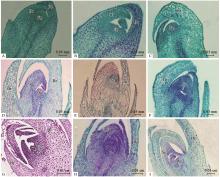
Fig.2
Section observation of the development of bracts, sepals and petal during the flowering stages of E. obtusifolia. A, B, C: Stage of bract differentiation in female, male and bisexual flower buds, respectively; D, E, F: Stage of Sepal differentiation in female, male and bisexual flower buds, respectively; G, H, I: Stage of petal differentiation in female, male and bisexual flower buds, respectively. Fp: Flower primordium; Br: Bracts; Se: Sepal primordia and sepals; Pe: Petal primordia. "

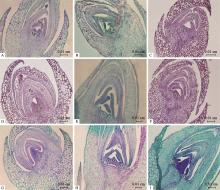
Fig.3
Section observation of the stage of stamen and pistil differentiation during the flowering stages of E. obtusifolia A: Initial differentiation of the pistil primordium in female flower buds; B: Initial differentiation of the primordium of pistil and stamen in male flower buds; C: Initial differentiation of the primordium of pistil and stamen in bisexual flower buds; D: Differentiation of the carpel primordium in female flower buds; E: Pistil and stamen primordia differentiate simultaneously in male flower buds; F: Differentiation of pistil and stamen primordia in bisexual flower buds; G: Basal union of carpel of female flower buds; H: Differentiation of carpels, anthers and filaments in male flower buds; I: Development of the primordium of pistil and stamen in bisexual flower buds. Br: Bracts; Se: Sepal primordia and sepals; Ep: Flower primordium; Pe: Petal primordia; Pi: Pistil primordium; St: Stamen primordium; Ca: Carpel primordium. "


Fig.4
Section observation of the stage of stamen and pistil formation during the flowering stages of E. obtusifolia A: Ovary formation in female flower buds; B: Anaphase of stamen primordium in male flower buds; C: Development of pistil and stamen in bisexual flower buds; D, E: Ovary development in female flower buds; F: Ovule development in female flower buds; G, H: The anther and filament development in male flower buds; I: Pistil degradation in bisexual flower buds. Pi: Pistil primordium; St: Stamen primordium; Ov: Ovary; Op: Ovules and ovule primordia; An: Anthers; Fi: Filaments. "

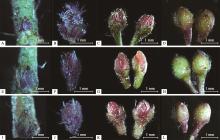
Fig.6
Morphological changes at early stage of flower bud differentiation of E. obtusifolia A, B, C, D: Stage of bract differentiation, sepal differentiation, petal differentiation and initial pistil differentiation in female flower buds, respectively; E, F, G, H: Stage of bract differentiation, sepal differentiation, petal differentiation and initial pistil and stamen differentiation in male flower buds, respectively; I, J, K, L: Stage of bract differentiation, sepal differentiation, petal differentiation and initial pistil and stamen differentiation in bisexual flower buds, respectively. "

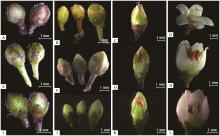
Fig.7
Morphological changes at late stage of flower bud differentiation of E. obtusifolia A: Late pistil differentiation in female flower buds; B: Early maturation of pistil and stamen in flower buds(left-right: bisexual, female, male flower buds); C: Anatomy of female flower buds in Fig. J; D: Female flower buds in early blooming; E: Late pistil and stamen differentiation in male flower buds; F: Middle maturation of pistil and stamen in flower buds(left-right: bisexual, female, male flower buds); G: Anatomy of male flower buds in Fig. J; H: Male flower buds in early blooming; I: Late pistil and stamen differentiation in bisexual flower buds; J: Late maturation of pistil and stamen in flower buds(left-right: bisexual, female, male flower buds); K: Anatomy of bisexual flower buds in Fig. J; L: Bisexual flower buds in early blooming. "

| 巴罗菊. 2017.细枝柃(Eurya loquaiana Dunn)花器官发生及激素动态变化研究.重庆:西南大学硕士学位论文. | |
| Ba L J. 2017. Study on floral organogenesis and dynamic changes of endogenous hormones of Eurya loquaiana Dunn. Chongqing: MS thesis of Southwest University.[in Chinese] | |
| 陈之端, 路安民. 被子植物起源和早期演化研究的回顾与展望. 植物分类学报, 1997. 35 (4): 375- 384. | |
| Chen Z R , Lu A M . Origin and early evolution of angiosperms retrospect and prospects. Acta Phytotaxonomica Sinica, 1997. 35 (4): 375- 384. | |
|
郜爱玲, 李建安, 刘儒, 等. 高等植物花芽分化机理研究进展. 经济林研究, 2010. 28 (2): 131- 136.
doi: 10.3969/j.issn.1003-8981.2010.02.029 |
|
|
Gao A L , Li J A , Liu R , et al. Advances in research on flower bud differentiation mechanism in higher plants. Nonwood Forest Research, 2010. 28 (2): 131- 136.
doi: 10.3969/j.issn.1003-8981.2010.02.029 |
|
|
冷琴, 杨洪. 被子植物起源:对老问题的新看法. 科学通报, 2001. 46 (5): 364- 370.
doi: 10.3321/j.issn:0023-074X.2001.05.004 |
|
|
Leng Q , Yang H . Origin of angiosperms:New views on old problems. Chinese Science Bulletin, 2001. 46 (5): 364- 370.
doi: 10.3321/j.issn:0023-074X.2001.05.004 |
|
| 李桂琴. 植物显微技术. 哈尔滨: 东北农业大学出版社. 2002. | |
| Li G Q . Plant microscopic technology. Harbin: Northeast Agricultural University Press. 2002. | |
| 李运婷. 2016.钝叶柃(Eurya obtusifolia H.T.Chang)性别分化的生理生化研究.重庆:西南大学硕士学位论文. | |
| Li Y T. 2016. Study of physiological and biochemical on sexual differentiation of Eurya obtusifolia H. T. Chang. Chongqing: MS thesis of Southwest University.[in Chinese] | |
| 李运婷, 宗秀虹, 张华雨, 等. 钝叶柃不同性别植株花期叶片内源激素含量的变化. 园艺学报, 2016. 43 (7): 1411- 1418. | |
| Li Y T , Zong X H , Zhang H Y , et al. Variation of endogenous hormones in the leaves of male, female and hermaphrodite plants of Eurya obtusifolia during flowering stages. Acta Horticulturae Sinic, 2016. 43 (7): 1411- 1418. | |
| 刘亭亭. 2007.白菜花发育过程的形态学、细胞学及超微结构观察.杭州:浙江大学硕士学位论文. | |
| Liu T T. 2007. Morphological, cytological and ultrastructural observations on the development of Chinese cabbage flowers. Hangzhou: MS thesis of Zhejiang University.[in Chinese] | |
| 吕柳新, 陶萌春, 潘仰星. 毛花猕猴桃(Actinidia eriantha Benth)的染色体与花粉母细胞减数分裂的观察. 福建农林大学学报:自然科学版, 1984. 13 (1): 25- 30. | |
| Lü L X , Tao M C , Pan Y X . Observation on the chromosome and meioses of pollen mother cells in Maohua gooseberry(Actinidia eriantha Benth). Journal of Fujian Agriculture and Forestry University:Natural Science Edition, 1984. 13 (1): 25- 30. | |
| 马德风, 梁诗魁. 中国蜜粉源植物及其利用. 北京: 农业出版社. 1993. | |
| Ma D F , Liang S K . The nectar and pollen resource plants in China and their utilization. Beijing: Agriculture Press. 1993. | |
| 施雁飞, 游新才, 张逸, 等. 茶树花芽分化解剖与形态学研究. 陕西师范大学学报:自然科学版, 2015. 43 (2): 70- 73. | |
| Shi Y F , You X C , Zhang Y , et al. Anatomy and morphological observation on flower bud differentiation of Camellia sinensis. Journal of Shaanxi Normal University:Natural Science Edition, 2015. 43 (2): 70- 73. | |
|
孙建云, 王庆亚, 黄清渊. 李花芽形态分化的研究. 江西农业大学学报, 2005. 27 (3): 413- 416.
doi: 10.3969/j.issn.1000-2286.2005.03.021 |
|
|
Sun J Y , Wang Q Y , Huang Q Y . A study on morphological differentiation of flower bud of Prunus salicina Lindl. Acta Agriculturae Universitatis Jiangxiensis, 2005. 27 (3): 413- 416.
doi: 10.3969/j.issn.1000-2286.2005.03.021 |
|
|
王彩云, 高莉萍, 鲁涤非, 等. '厚瓣金桂'桂花花芽形态分化的研究. 园艺学报, 2002. 29 (1): 52- 56.
doi: 10.3321/j.issn:0513-353X.2002.01.012 |
|
|
Wang C Y , Gao L P , Lu D F , et al. A study on morphological differentiation of flower bud of Osmanthus fragrans 'Houban Jingui'. Acta Horticulturae Sinica, 2002. 29 (1): 52- 56.
doi: 10.3321/j.issn:0513-353X.2002.01.012 |
|
| 王茜, 邓洪平, 丁博, 等. 钝叶柃不同性别花的花部形态与传粉特征比较. 生态学报, 2012. 32 (12): 3921- 3930. | |
| Wang Q , Deng H P , Ding B , et al. Comparison of floral morphology and pollination characteristics between the sexes in Eurya loquaiana. Acta Ecologica Sinica, 2012. 32 (12): 3921- 3930. | |
|
王湘南, 蒋丽娟, 陈永忠, 等. 花芽分化的形态解剖学特征观测. 中南林业科技大学学报, 2011. 31 (8): 22- 27.
doi: 10.3969/j.issn.1673-923X.2011.08.005 |
|
|
Wang X N , Jiang L J , Chen Y Z , et al. Observation on morphological and anatomical characteristics of the flower bud differentiation on Camellia oleifera.. Journal of Central South University of Forestry & Technology, 2011. 31 (8): 22- 27.
doi: 10.3969/j.issn.1673-923X.2011.08.005 |
|
|
杨康民, 夏瑞妹, 戚五妹. 上海地区桂花品种开花性状的分析研究. 园艺学报, 1989. 16 (2): 146- 152.
doi: 10.3321/j.issn:0513-353X.1989.02.008 |
|
|
Yang K M , Xia R M , Qi W M . An investigation and analysis on the cultivars of sweet osmanthus and their blooming characteristics in Shanghai. Acta Horticulturae Sinica, 1989. 16 (2): 146- 152.
doi: 10.3321/j.issn:0513-353X.1989.02.008 |
|
| 张波, 秦垦, 何昕孺, 等. 木本植物花芽分化研究进展. 湖北农业科学, 2017. 56 (22): 4224- 4226. | |
| Zhang B , Qin K , He X R , et al. Research progress of flower bud differentiation mechanism of woody plants. Hubei Agricultural Sciences, 2017. 56 (22): 4224- 4226. | |
| 张大勇. 植物生活史进化与繁殖生态学. 北京: 科学出版社. 2004. | |
| Zhang D Y . Plant life-history evolution and reproductive ecology. Beijing: Science Press. 2004. | |
| 张逸. 茶树花芽分化及花器官发育的形态学研究. 西安: 陕西师范大学. 2012. | |
| Zhang Y . Morphological study on flower bud differentiation and flower organ development of tea. Xi'an: Shaanxi Normal University. 2012. | |
| 张瑞菊. 2006.厚皮香科植物的花器官发生及其系统学意义.昆明:云南大学硕士学位论文. | |
| Zhang R J. 2006. Floral organogenesis and its systematic significance of Pseudostellaceae. Kunming: MS thesis of Yunnan University.[in Chinese] | |
| 朱雯, 许逸林, 李文锋, 等. 广宁红花油茶花芽分化特征. 广东农业科学, 2016. 43 (3): 51- 54. | |
| Zhu W , Xu Y L , Li W F , et al. Study on flower bud differentiation characteristics of Camellia semiserrata Chi. Guangdong Agricultural Sciences, 2016. 43 (3): 51- 54. | |
|
Anderson G J , Anderson M K J , Patel N . The ecology, evolution, and biogeography of dioecy in the genus Solanum: with paradigms from the strong dioecy in Solanum polygamum, to the unsuspected and cryptic dioecy in Solanum conocarpum. American Journal of Botany, 2015. 102 (3): 471- 486.
doi: 10.3732/ajb.1400486 |
|
| Aryal R , Ming R . Sex determination in flowering plants:Papaya as a model system. Plant Science, 2014. 217/218 (1): 56- 62. | |
| Calderon-Urrea D A . Special review issue on plant reproduction sex determination in flowering plants. The Plant Cell, 1993. 5 (10): 1241- 1251. | |
| Martine C T , Anderson G J , Jordon-Thaden I , et al. Leakiness may be an insurance policy for functionally dioecious Solanum of oceanic and terrestrial islands. Botany, 2014. 2014, 26- 30. | |
|
Mitchell C H , Diggle P K . The evolution of unisexual flowers:morphological and functional convergence results from diverse developmental transitions. American Journal of Botany, 2005. 92 (7): 1068- 1076.
doi: 10.3732/ajb.92.7.1068 |
|
| Venkatasamy S , Khittoo G , Keeley S . Leaky dioecy in Diospyros (Ebenaceae) endemic to the island of Mauritius. Plant Ecology, 2007. 189 (1): 139- 146. |
| [1] | Xiaoli Yan,Wenjia Hu,Yuanfan Ma,yufan Huo,Tuo Wang,Xiangqing Ma. Nitrogen Uptake Preference of Cunninghamia lanceolata, Pinus massoniana, and Schima superba under Heterogeneous Nitrogen Supply Environment and their Root Foraging Strategies [J]. Scientia Silvae Sinicae, 2020, 56(2): 1-11. |
| [2] | Wang Yi, Jia Zhongkui, Ma Lüyi, Deng Shixin, Zhu Zhonglong, Sang Ziyang. Effects of Four Plant Growth Regulators on Rooting of the Softwood Cutting of Magnolia wufengensis [J]. Scientia Silvae Sinicae, 2019, 55(7): 35-45. |
| [3] | Guan Jiyuan, Fan Weiguo. Relationship Between Growth and Root Morphological Characteristics of Rosa roxbunghii Seedlings and Endogenous Hormone Content Under Different Phosphorus Levels [J]. Scientia Silvae Sinicae, 2019, 55(4): 51-61. |
| [4] | Songyan Zou,Doudou Li,Jinsong Wang,Nan Di,Jinqiang Liu,Ye Wang,Guangde Li,Jie Duan,Liming Jia,Benye Xi. Response of Fine Roots to Soil Moisture of Different Gradients in Young Populus tomentosa Plantation [J]. Scientia Silvae Sinicae, 2019, 55(10): 124-137. |
| [5] | Li Yongliang, Zhang Huaiqing, Yang Tingdong, Ma Zaiyang, He Changping, Li Sijia. Vein Detection Method Based on Fuzzy Logic and Multiple Order Morphology [J]. Scientia Silvae Sinicae, 2018, 54(5): 70-77. |
| [6] | Wu Ju, Chen Yu, Liu Haixuan, Xu Lijuan, Jin Guixiang, Xu Chengyang. Effects of Stand Density and Mingling Intensity on Tree Morphology in Natural Scenic Forest in Changbai Mountain [J]. Scientia Silvae Sinicae, 2018, 54(12): 12-21. |
| [7] | Hou Hanqing, Su Chengyuan, Pang Yin, Liu Zhiwei, Zhu Daohong. A New Gall Wasp Species Dryocosmus zhuili (Hymenoptera: Cynipidae)Attacking Castanea henryi: Its Distribution, Damage and Parasitoid Species [J]. Scientia Silvae Sinicae, 2018, 54(10): 89-97. |
| [8] | Li Huan, Li Mingze, Fan Wenyi, Wang Bin. Canopy Gap Structure Parameters Extraction Based on Light Detection and Ranging(LiDAR) [J]. Scientia Silvae Sinicae, 2018, 54(10): 98-107. |
| [9] | Tang Xiaoqin, Zang Jiancheng, Lu Jie. Bionomics of Soritia leptalina(Lepidoptera: Zygaenidae)in Quercus aquifolioides Tree [J]. Scientia Silvae Sinicae, 2017, 53(6): 175-180. |
| [10] | Zhu Kaiyue, Wang Qingcheng, Wu Wenjuan. Effect of Gap Size on Growth and Morphology of Transplanted Saplings of Quercus mongolica and Fraxinus mandshurica [J]. Scientia Silvae Sinicae, 2017, 53(4): 150-157. |
| [11] | Hu Jiawei, Liu Yong, Wang Yan, Lou Junshan, Li Guolei. Effects of Mushroom Residue Compost on Growth and Nutrient Uptake of Pinus tabulaeformis Container Seedlings [J]. Scientia Silvae Sinicae, 2017, 53(2): 129-137. |
| [12] | Xing Zefeng, Li Ying, Deng Rongxin, Zhu Honglei, Fu Bolin. Extracting Farmland Shelterbelt Automatically Based on ZY-3 Remote Sensing Images [J]. Scientia Silvae Sinicae, 2016, 52(4): 11-20. |
| [13] | Guo Hongyan, Wang Sen, Yan Chao, Zhang Zhen, Huang Wen. Characteristics of Male Flower and Its Pollen of Schisandra sphenanthera [J]. Scientia Silvae Sinicae, 2016, 52(3): 112-120. |
| [14] | Chen Zhiyu, Wu Pengfei, Zou Xianhua, Wang Pan, Ma Jing, Ma Xiangqing. Relationship between Growth and Endogenous Hormones of Chinese Fir Seedlings under Low Phosphorus Stress [J]. Scientia Silvae Sinicae, 2016, 52(2): 57-66. |
| [15] | Yang Sheng, Hao Guowei, Zhang Xiaowei, Bai Mudan, Li Kai, Shi Meijuan, Cheng Peihong, Guo Huangping, Li Liulin. Effects of Mineral Nutrition on Formation of Wizened Bud in ‘Yuluxiangli’ Pear [J]. Scientia Silvae Sinicae, 2016, 52(2): 127-133. |
| Viewed | ||||||
|
Full text |
|
|||||
|
Abstract |
|
|||||